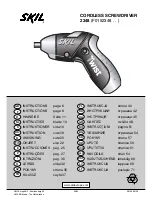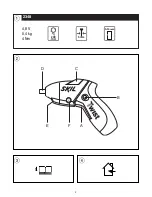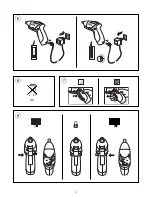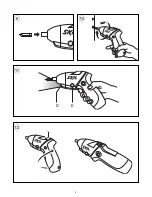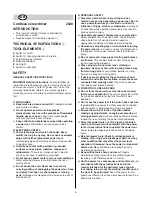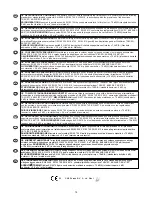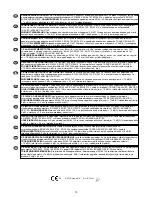
5) BATTERY TOOL USE AND CARE
a)
Recharge only with the charger specified by the
manufacturer.
A charger that is suitable for one type of
battery pack may create a risk of fire when used with
another battery pack.
b)
Under abusive conditions, liquid may be ejected
from the battery; avoid contact. If contact
accidentally occurs, flush with water. If liquid
contacts eyes, additionally seek medical help.
Liquid
ejected from the battery may cause irritation or burns.
6) SERVICE
a)
Have your power tool serviced by a qualified repair
person using only identical replacement parts.
This
will ensure that the safety of the power tool is
maintained.
SAFETY INSTRUCTIONS FOR CORDLESS DRIVERS
●
Avoid damage that can be caused by screws, nails and
other elements in your workpiece; remove them before
you start working
●
Always check that the supply voltage is the same as the
voltage indicated on the nameplate of the charger
(chargers with a rating of 230V or 240V can also be
connected to a 220V supply)
●
In case of electrical or mechanical malfunction,
immediately switch off the tool or unplug charger from
power source
●
SKIL can assure flawless functioning of the tool only
when original accessories are used
●
This tool should not be used by people under the age of
16 years
●
Be careful not to drive into areas where electrical wires
may be contacted
●
Ensure that switch B
2
is in the middle (locking)
position before making any adjustments or changing
accessories as well as when carrying or storing the tool
CHARGING/BATTERIES
●
Charge battery only with the charger that is supplied
with the tool
●
Do not expose tool/charger to rain
●
Never charge battery outdoors
4
●
Store tool/charger in locations where temperature will
not exceed 40° C or drop below 0° C
●
Batteries will explode in fire, so do not burn battery for
any reason
●
When damaged, and under extreme usage and
temperature conditions, batteries may start to leak
- if liquid comes into contact with the skin, wash quickly
with soap and water, then with lemon juice or vinegar
- if liquid gets into the eyes, flush eyes with clean water
for a minimum of 10 minutes and seek immediately
medical attention
●
Do not use charger when cord or plug is damaged; cord
or plug should be replaced immediately at one of the
officially registered SKIL Service Stations
●
Do not disassemble charger or tool
USE
●
Charging battery
5
- battery of new tools is not fully charged
! unplug the charger from the tool after charging
period has ended thereby lengthening the service
life of the battery
IMPORTANT:
- while charging, the charger and the battery may
become warm to touch; this is normal and does not
indicate a problem
- do not charge at temperatures below 0° C and over
40° C; this will seriously damage the battery as well
as the charger
- when you charge the battery for the first time, it only
accepts 80% of its maximum capacity; after several
charges and discharges, however, the batteries
should be at full capacity and deliver maximum
performance
- do not repeatedly recharge the battery after only a
few minutes of operation; this may result in a
reduction of operating time and battery efficiency
- the nickel-cadmium battery must be kept separate
from the natural environment and should not be
disposed of as normal domestic waste
$
(symbol
6
will remind you of this when the need for disposing
occurs)
! prior to disposal protect battery terminals with
heavy tape to prevent short-circuit
- if you anticipate long periods of non-use for the tool, it
is best to unplug the charger from its power source
●
On/Off
7
●
Changing direction of rotation
8
- when not properly set in left/right position, switch A
2
cannot be activated
! change direction of rotation only when tool is at a
complete standstill
●
Changing bits
9
- push bit to end position in bit holder
! do not use bits with a damaged shank
●
Automatic spindle-lock
Allows you to manually tighten or loosen screws, when
necessary
0
●
Spot light
!
Switch on/off spot light E by pressing switch F
●
Two handle positions
@
1 - for normal screwdriving
2 - for screwdriving in hard-to-reach places
- for optimal results when tightening/loosening screws
manually
APPLICATION ADVICE
●
Use the appropriate bits
#
! do not use damaged bits
! only use bits with hexagon shaft
●
When turning in a screw at/near the cross cut end or an
edge of wood one should pre-drill a hole in order to
avoid cracking of the wood
7
Summary of Contents for Twist 2348
Page 2: ...2 2348 4 8 V 0 4 kg 4 Nm 200 1 5 mm 3 5 hours D C E F A B 2 3 4...
Page 3: ...3 Cd 6 7 5 8...
Page 4: ...4 D E 9 0...
Page 5: ...5 PHILLIPS POZIDRIV SLOTTED TORX...
Page 11: ......

